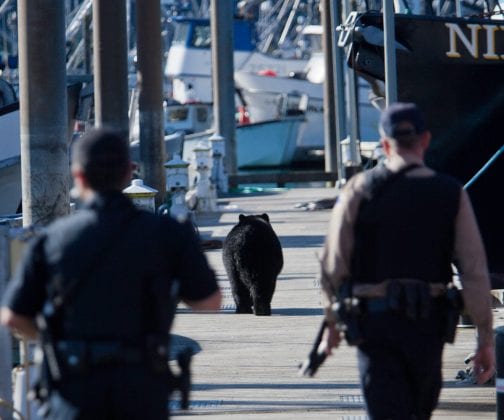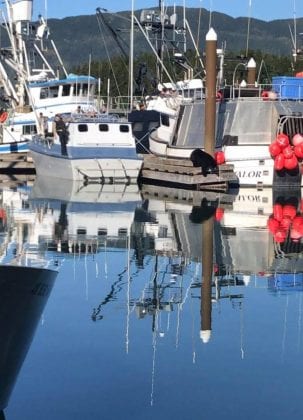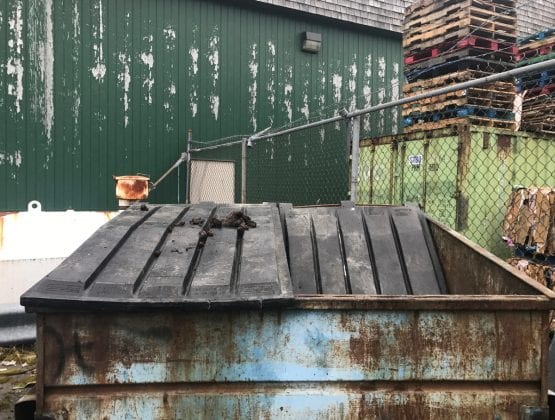Editor’s note: This story has been updated since Friday’s print edition went to press.
A perfect storm of hungry bears, a dismal year for salmon and berries, and tempting dumpsters has proven deadly for 23 bruins in Cordova and Valdez so far this year.
That’s the highest number of bear kills in the two communities since 11 were shot in 2006.
“I don’t believe this is the way we were meant to interact with other species,” said Charlotte Westing, Prince William Sound area wildlife biologist with the Cordova office of the Alaska Department of Fish and Game.
In Cordova, five bears were killed by authorities and nine others in defense of life and property incidents, while in Valdez seven bears were shot by authorities and two others for defense of life and property. Agency kills include any bear killed by ADF&G, the Police Department, or the Alaska Wildlife Troopers.
Ten of the Cordova kills have occurred since Aug. 31.
One of those incidents involved a black bear sow, known locally as “harbor bear,” who was found feeding on rice dumped in a parking lot in the south fill, near the harbor, Westing said. The sow then began dumpster diving and eventually made her way to the docks.
ADF&G did not feel comfortable hazing the bear as crowds of people began to form.
The bear, who weighed close to 200 pounds, was fatally shot two days later on Sept. 8 by Alaska Wildlife Troopers after it swam in the harbor, climbed onto boats and walked along the docks.
While there was no natural food for bears at the south fill, the bear continued to search and find garbage left accessible by people, Westing said.
“This bear has lived peacefully in the proximity of the community for well over a decade,” Westing said. “This is all preventable.”
Preliminary testing of a sample tooth from that sow showed her to be about 12 years old.
Once the bear accessed food from the Baja Taco dumpster, owner and chef Andra Doll immediately removed all waste. Then she left the plastic lids open so the bear would not ruin them. Doll spent her day cooking and shooing away the bear, simultaneously.
“The … only solution is to take the food away from the bears,” she said.
Doll said the bear revisited the dumpster four times after it was emptied on Sept. 5. Beginning that day, and for numerous days after, she personally hauled trash to the baler. The city eventually fitted the dumpster at Baja Taco with a bear-proof lid.
“But there’s not enough (bear proof lids) to go around,” Doll said of the lid, noting dumpsters around town frequented by the bears.
Westing works closely with Police Chief Mike Hicks and Alaska Wildlife Troopers Sgt. Robin Morrisett to update information and plans regarding the bears.
“Those guys don’t wanna shoot bears,” she said. “They wanna crack down on opioids.”
Just last week, a black bear caused a commotion at Coast Guard housing, located off of Lake Avenue.
“When the children were out playing last week around 5:30 (p.m.), a bunch of us adults had to chase it from between our houses,” resident Heidi Ritter said. “It was heading toward the playground in housing here. It wasn’t scared.”
Adults began shouting and clapping after the noise of kids and a lawnmower didn’t seem to affect the bear, who continued to walk briskly towards the noise, Ritter said.
After multiple people got involved, the bear eventually ran off.
“I felt like I was going full ‘mama bear’ on an actual real-life bear!” Ritter said.
Ritter said the housing complex is kept “really tidy” and that to her knowledge the dumpsters are emptied multiple times a week and never overflowing.
“There is a game trail that the bears have paved that leads right out next to the swing set,” she said. “It’s like it’s part of their routine.”
Earlier in the month, a sow and cub entered a home through an open sliding door, poking out the screen, Westing said. The bears had previously entered a neighboring home through a large dog door.
“It was a combination of behaviors that couldn’t be tolerated,” Westing said of the bears who were eventually killed. “This time of year, the bears are completely obsessed with food.”
On Sept. 1 the fish cleaning station located near the city burn pile on Orca Road was shut down after eight bears were seen at one time, Westing said.
People were getting too close to the bears and throwing scraps of salmon to them.
“They think they’re helping the bears, but what they’re really doing is making them more likely to die,” Westing said.
The bears are currently going through hyperphagia, excessive eating and gorging on food, and due to a dismal berry season are now finding food sources elsewhere.
Westing and other wildlife biologists across southcentral and southeast Alaska have noticed a large influx of one- and two-year-old bears with higher caloric demands have a broader geographic range and gravitate towards less prime food sources because larger bears have already claimed their stake.
“The bear population in this area was down following Snowpocalypse,” Westing said referring to the winter of 2011/2012, when Cordova received 27 feet of snow. “Since then, I believe it’s increasing but probably from a low point.”
Through a collaborative collared tracking project between the U.S. Forest Service and ADF&G, bears have been seen using the country in a different manner which shows the resources available, including one bear whose footprint of habitat usage is four times what it had been in past years.
While bears seeking food put the community in danger, people attempting to kill bears within city limits poses a greater threat, Westing said. “The issue is the overall mentality of people in town,” she added.
Bears are important to Alaska’s ecosystem, delivering marine driven nutrients to vital parts of the landscapes through scat containing nutrients from a heavy diet of salmon, she said.
“Presence of bears influences salmon productivity, influences moose productivity,” she said. “Cordova is a resource extractive town. I feel like everything has value in ecosystems.”
To that end, Westing continues to advocate for the city providing neighborhood bear-resistant dumpsters as a secure place for trash.
City Manager Alan Lanning said the city will be assessing possibilities including purchasing bear-proof containers, reviewing ordinances that require electric fencing for chickens and reevaluating how people have to handle their refuse. He noted these possibilities were dependent on the feasibility of the city budget.
“At its core, it is a trash issue,” Westing said. “If you have never been careful about your trash, be careful about it now.”

























